人力资源管理专业导论(1)
- 格式:ppt
- 大小:1.08 MB
- 文档页数:116
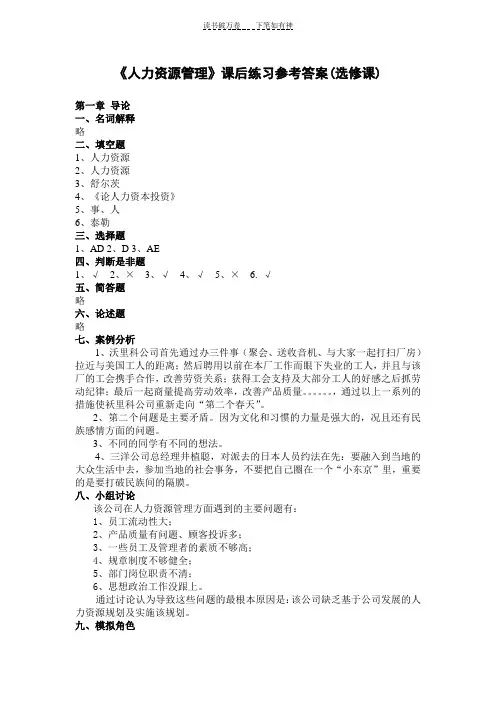
《人力资源管理》课后练习参考答案(选修课)第一章导论一、名词解释略二、填空题1、人力资源2、人力资源3、舒尔茨4、《论人力资本投资》5、事、人6、泰勒三、选择题1、AD2、D3、AE四、判断是非题1、√2、×3、√4、√5、× 6. √五、简答题略六、论述题略七、案例分析1、沃里科公司首先通过办三件事(聚会、送收音机、与大家一起打扫厂房)拉近与美国工人的距离;然后聘用以前在本厂工作而眼下失业的工人,并且与该厂的工会携手合作,改善劳资关系;获得工会支持及大部分工人的好感之后抓劳动纪律;最后一起商量提高劳动效率,改善产品质量。
,通过以上一系列的措施使袄里科公司重新走向“第二个春天”。
2、第二个问题是主要矛盾。
因为文化和习惯的力量是强大的,况且还有民族感情方面的问题。
3、不同的同学有不同的想法。
4、三洋公司总经理井植聪,对派去的日本人员约法在先:要融入到当地的大众生活中去,参加当地的社会事务,不要把自己圈在一个“小东京”里,重要的是要打破民族间的隔膜。
八、小组讨论该公司在人力资源管理方面遇到的主要问题有:1、员工流动性大;2、产品质量有问题、顾客投诉多;3、一些员工及管理者的素质不够高;4、规章制度不够健全;5、部门岗位职责不清;6、思想政治工作没跟上。
通过讨论认为导致这些问题的最根本原因是:该公司缺乏基于公司发展的人力资源规划及实施该规划。
九、模拟角色不妥当。
1、该厂花大量的精力来处理人才外流问题,还不如反省自身的做法,对如何留住现有的技术骨干拿出具体措施,发挥现有技术人员的积极性,上海毕竟是大都市,有好的人才政策还是能把人才留住的。
2、明智的办法应向哪些离开钢琴厂的员工对为厂多年工作表示感谢,并拿出一系列办法解决要离开厂的员工的实际问题。
这些员工实在想走,就应该让高兴地他们走,说不定以后还会有合作的机会呢。
第二章人力资源管理的理论基础一、名词解释略二、选择题1、A2、A3、B三、简答题略四、论述题略五、案例分析1、罗拔通过精神奖励和物质奖励、员工参与的管理方法,使职工具有成就感、荣誉感,从而提高职工的积极性。
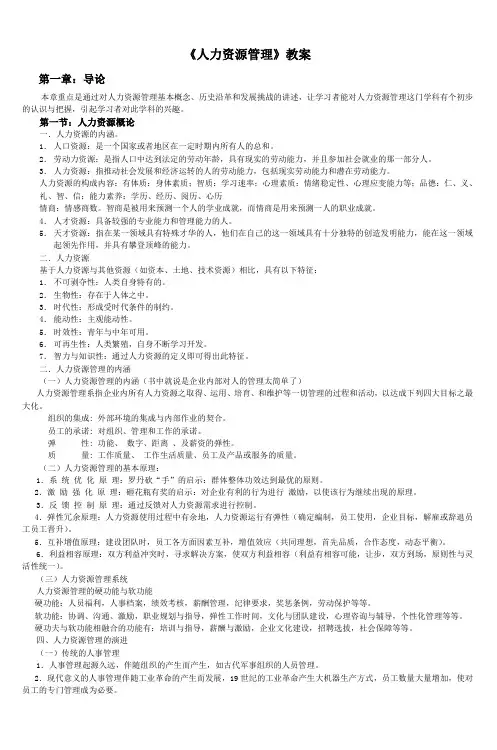
《人力资源管理》教案第一章:导论本章重点是通过对人力资源管理基本概念、历史沿革和发展挑战的讲述,让学习者能对人力资源管理这门学科有个初步的认识与把握,引起学习者对此学科的兴趣。
第一节:人力资源概论一.人力资源的内涵。
1.人口资源:是一个国家或者地区在一定时期内所有人的总和。
2.劳动力资源:是指人口中达到法定的劳动年龄,具有现实的劳动能力,并且参加社会就业的那一部分人。
3.人力资源:指推动社会发展和经济运转的人的劳动能力,包括现实劳动能力和潜在劳动能力。
人力资源的构成内容:有体质:身体素质;智质:学习速率;心理素质:情绪稳定性、心理应变能力等;品德:仁、义、礼、智、信;能力素养:学历、经历、阅历、心历情商:情感商数。
智商是被用来预测一个人的学业成就,而情商是用来预测一人的职业成就。
4.人才资源:具备较强的专业能力和管理能力的人。
5.天才资源:指在某一领域具有特殊才华的人,他们在自己的这一领域具有十分独特的创造发明能力,能在这一领域起领先作用,并具有攀登顶峰的能力。
二.人力资源基于人力资源与其他资源(如资本、土地、技术资源)相比,具有以下特征:1.不可剥夺性:人类自身特有的。
2.生物性:存在于人体之中。
3.时代性:形成受时代条件的制约。
4.能动性:主观能动性。
5.时效性:青年与中年可用。
6.可再生性:人类繁殖,自身不断学习开发。
7.智力与知识性:通过人力资源的定义即可得出此特征。
二.人力资源管理的内涵(一)人力资源管理的内涵(书中就说是企业内部对人的管理太简单了)人力资源管理系指企业内所有人力资源之取得、运用、培育、和维护等一切管理的过程和活动,以达成下列四大目标之最大化。
组织的集成: 外部环境的集成与内部作业的契合。
员工的承诺: 对组织、管理和工作的承诺。
弹性: 功能、数字、距离、及薪资的弹性。
质量: 工作质量、工作生活质量、员工及产品或服务的质量。
(二)人力资源管理的基本原理:1.系统优化原理:罗丹砍“手”的启示:群体整体功效达到最优的原则。
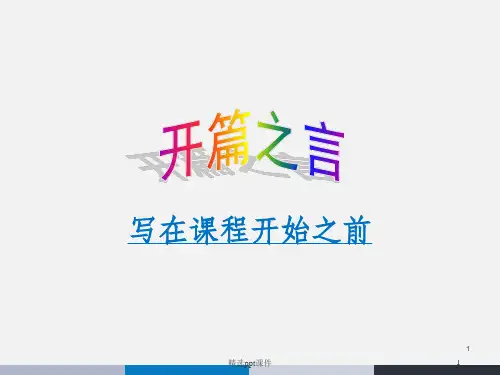
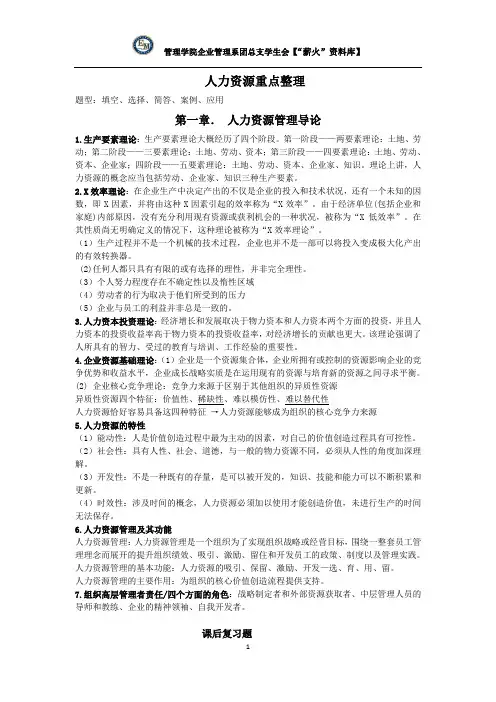
人力资源重点整理题型:填空、选择、简答、案例、应用第一章.人力资源管理导论1.生产要素理论:生产要素理论大概经历了四个阶段。
第一阶段——两要素理论:土地、劳动;第二阶段——三要素理论:土地、劳动、资本;第三阶段——四要素理论:土地、劳动、资本、企业家;四阶段——五要素理论:土地、劳动、资本、企业家、知识。
理论上讲,人力资源的概念应当包括劳动、企业家、知识三种生产要素。
2.X效率理论:在企业生产中决定产出的不仅是企业的投入和技术状况,还有一个未知的因数,即X因素,并将由这种X因素引起的效率称为“X效率”。
由于经济单位(包括企业和家庭)内部原因,没有充分利用现有资源或获利机会的一种状况,被称为“X低效率”。
在其性质尚无明确定义的情况下,这种理论被称为“X效率理论”。
(1)生产过程并不是一个机械的技术过程,企业也并不是一部可以将投入变成极大化产出的有效转换器。
(2)任何人都只具有有限的或有选择的理性,并非完全理性。
(3)个人努力程度存在不确定性以及惰性区域(4)劳动者的行为取决于他们所受到的压力(5)企业与员工的利益并非总是一致的。
3.人力资本投资理论:经济增长和发展取决于物力资本和人力资本两个方面的投资,并且人力资本的投资收益率高于物力资本的投资收益率,对经济增长的贡献也更大。
该理论强调了人所具有的智力、受过的教育与培训、工作经验的重要性。
4.企业资源基础理论:(1)企业是一个资源集合体,企业所拥有或控制的资源影响企业的竞争优势和收益水平,企业成长战略实质是在运用现有的资源与培育新的资源之间寻求平衡。
(2)企业核心竞争理论:竞争力来源于区别于其他组织的异质性资源异质性资源四个特征:价值性、稀缺性、难以模仿性、难以替代性人力资源恰好容易具备这四种特征→人力资源能够成为组织的核心竞争力来源5.人力资源的特性(1)能动性:人是价值创造过程中最为主动的因素,对自己的价值创造过程具有可控性。
(2)社会性:具有人性、社会、道德,与一般的物力资源不同,必须从人性的角度加深理解。
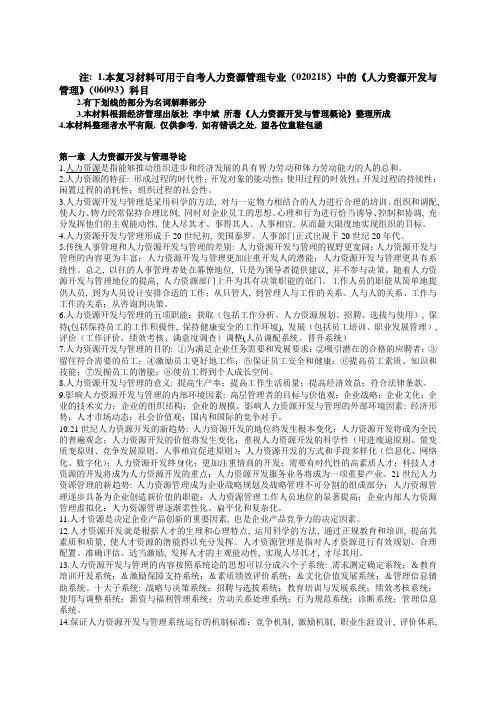
注: 1.本复习材料可用于自考人力资源管理专业(020218)中的《人力资源开发与管理》(06093)科目2.有下划线的部分为名词解释部分3.本材料根据经济管理出版社李中斌所著《人力资源开发与管理概论》整理所成4.本材料整理者水平有限, 仅供参考, 如有错误之处, 望各位童鞋包涵第一章人力资源开发与管理导论1.人力资源是指能够推动组织进步和经济发展的具有智力劳动和体力劳动能力的人的总和。
2.人力资源的特征: 形成过程的时代性;开发对象的能动性;使用过程的时效性;开发过程的持续性;闲置过程的消耗性;组织过程的社会性。
3.人力资源开发与管理是采用科学的方法, 对与一定物力相结合的人力进行合理的培训、组织和调配, 使人力、物力经常保持合理比例, 同时对企业员工的思想、心理和行为进行恰当诱导、控制和协调, 充分发挥他们的主观能动性, 使人尽其才、事得其人、人事相宜, 从而最大限度地实现组织的目标。
4.人力资源开发与管理形成于20世纪初, 美国泰罗。
人事部门正式出现于20世纪20年代。
5.传统人事管理和人力资源开发与管理的差别: 人力资源开发与管理的视野更宽阔;人力资源开发与管理的内容更为丰富;人力资源开发与管理更加注重开发人的潜能;人力资源开发与管理更具有系统性。
总之, 以往的人事管理者处在幕僚地位, 只是为领导者提供建议, 并不参与决策。
随着人力资源开发与管理地位的提高, 人力资源部门上升为具有决策职能的部门。
工作人员的职能从简单地提供人员, 到为人员设计安排合适的工作;从只管人, 到管理人与工作的关系、人与人的关系、工作与工作的关系;从咨询到决策。
6.人力资源开发与管理的五项职能:获取(包括工作分析、人力资源规划、招聘、选拔与使用), 保持(包括保持员工的工作积极性, 保持健康安全的工作环境), 发展(包括员工培训、职业发展管理),评价(工作评价、绩效考核、满意度调查)调整(人员调配系统、晋升系统)7.人力资源开发与管理的目的: ①为满足企业任务需要和发展要求;②吸引潜在的合格的应聘者;③留住符合需要的员工;④激励员工更好地工作;⑤保证员工安全和健康;⑥提高员工素质、知识和技能;⑦发掘员工的潜能;⑧使员工得到个人成长空间。
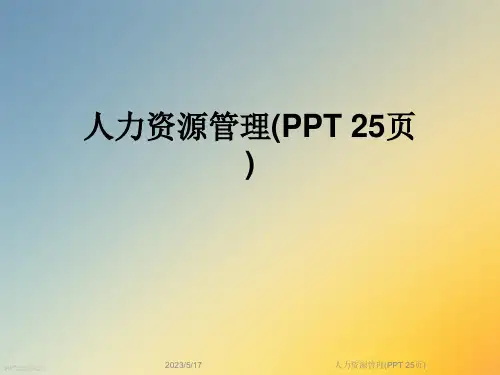

《人力资源管理》教案第一章:导论本章重点是通过对人力资源管理基本概念、历史沿革和发展挑战的讲述,让学习者能对人力资源管理这门学科有个初步的认识与把握,引起学习者对此学科的兴趣。
第一节:人力资源概论一.人力资源的内涵。
1.人口资源:是一个国家或者地区在一定时期内所有人的总和。
2.劳动力资源:是指人口中达到法定的劳动年龄,具有现实的劳动能力,并且参加社会就业的那一部分人。
3.人力资源:指推动社会发展和经济运转的人的劳动能力,包括现实劳动能力和潜在劳动能力。
人力资源的构成内容:有体质:身体素质;智质:学习速率;心理素质:情绪稳定性、心理应变能力等;品德:仁、义、礼、智、信;能力素养:学历、经历、阅历、心历情商:情感商数。
智商是被用来预测一个人的学业成就,而情商是用来预测一人的职业成就。
4.人才资源:具备较强的专业能力和管理能力的人。
5.天才资源:指在某一领域具有特殊才华的人,他们在自己的这一领域具有十分独特的创造发明能力,能在这一领域起领先作用,并具有攀登顶峰的能力。
二.人力资源基于人力资源与其他资源(如资本、土地、技术资源)相比,具有以下特征:1.不可剥夺性:人类自身特有的。
2.生物性:存在于人体之中。
3.时代性:形成受时代条件的制约。
4.能动性:主观能动性。
5.时效性:青年与中年可用。
6.可再生性:人类繁殖,自身不断学习开发。
7.智力与知识性:通过人力资源的定义即可得出此特征。
二.人力资源管理的内涵(一)人力资源管理的内涵(书中就说是企业内部对人的管理太简单了)人力资源管理系指企业内所有人力资源之取得、运用、培育、和维护等一切管理的过程和活动,以达成下列四大目标之最大化。
组织的集成: 外部环境的集成与内部作业的契合。
员工的承诺: 对组织、管理和工作的承诺。
弹性: 功能、数字、距离、及薪资的弹性。
质量: 工作质量、工作生活质量、员工及产品或服务的质量。
(二)人力资源管理的基本原理:1.系统优化原理:罗丹砍“手”的启示:群体整体功效达到最优的原则。
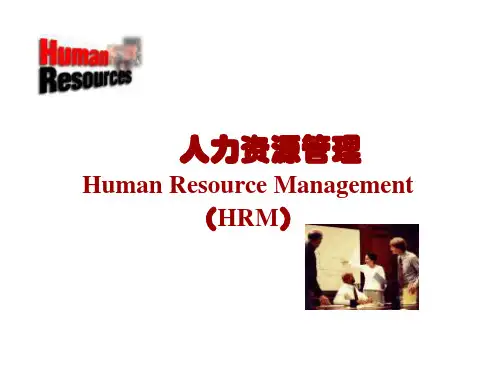
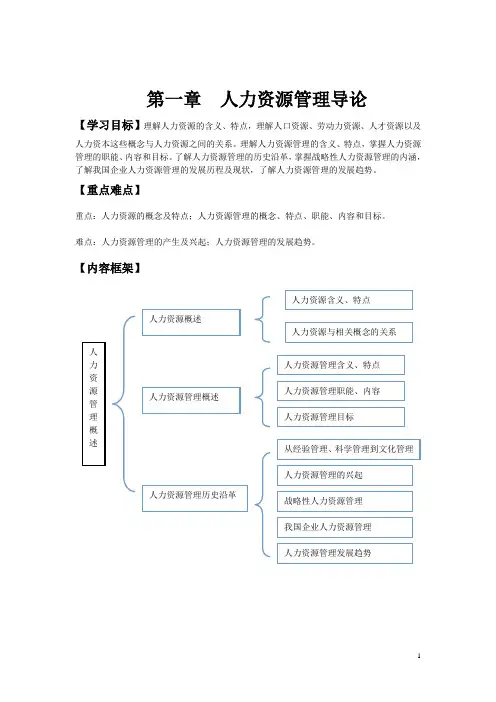
第一章人力资源管理导论【学习目标】理解人力资源的含义、特点,理解人口资源、劳动力资源、人才资源以及人力资本这些概念与人力资源之间的关系。
理解人力资源管理的含义、特点,掌握人力资源管理的职能、内容和目标。
了解人力资源管理的历史沿革,掌握战略性人力资源管理的内涵,了解我国企业人力资源管理的发展历程及现状,了解人力资源管理的发展趋势。
【重点难点】重点:人力资源的概念及特点;人力资源管理的概念、特点、职能、内容和目标。
难点:人力资源管理的产生及兴起;人力资源管理的发展趋势。
【内容框架】人力资源管理概述人力资源概述人力资源管理概述人力资源管理历史沿革人力资源含义、特点人力资源与相关概念的关系人力资源管理含义、特点从经验管理、科学管理到文化管理人力资源管理职能、内容人力资源管理目标我国企业人力资源管理战略性人力资源管理人力资源管理的兴起人力资源管理发展趋势【引导案例】海尔的人力资源管理海尔——中国家电行业的一艘航空母舰,不仅在中国,甚至世界,海尔的名字都是家喻户晓。
学习GE,冲进世界500强,海尔提出的这些口号曾经令中国企业界为之震动。
而正如众人所知,作为第一家登上哈佛商学院讲堂的中国企业,海尔集团已成为中国现代企业经营成功的一个典范。
其成功的关键在于人,包括选人、用人、育人和留人。
“国际化的企业,国际化的人”--海尔人力资源开发目标在总裁张瑞敏“走国际化的道路,创世界名牌”的思想指导下,海尔集团通过实施名牌战略、多元化战略和国际化战略,取得了持续稳定高速的增长,其品牌价值不但稳定居中国家电业榜首,在国际市场的美誉度也越来越高。
海尔清醒地认识到,在目前这种环境下,要想成为国际化的名牌,每一个员工首先应成为国际化的人才。
因此,海尔集团人力资源开发的目标,必须适应企业实施国际化战略的大目标,为企业培养真正具备国际化素质和国际竞争力的人才。
“赛马不相马”--海尔人力资源开发原则海尔在人力资源开发过程中始终坚持观念创新、制度创新;坚持创造一种公平、公正、公开的氛围,建立一套充分发挥个人潜能的机制,在实现企业大目标的同时,给每个人提供充分实现自我价值的发展空间--“你能翻多大的跟头,就给你搭多大的舞台”。
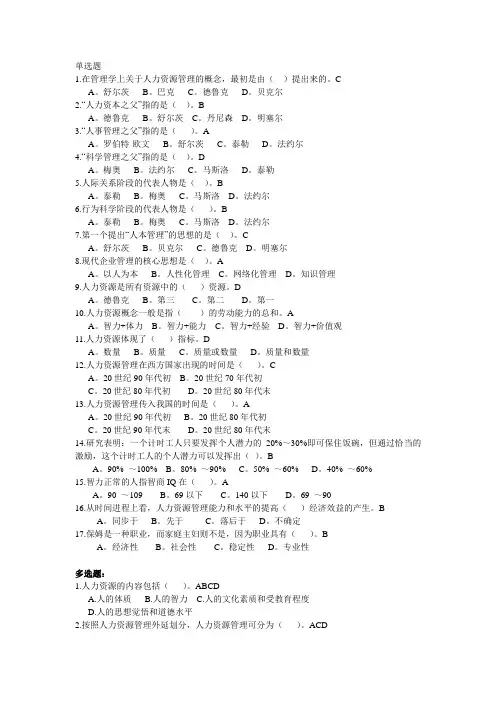
单选题1.在管理学上关于人力资源管理的概念,最初是由()提出来的。
CA。
舒尔茨B。
巴克C。
德鲁克D。
贝克尔2.“人力资本之父”指的是()。
BA。
德鲁克B。
舒尔茨C。
丹尼森D。
明塞尔3.“人事管理之父”指的是()。
AA。
罗伯特·欧文B。
舒尔茨C。
泰勒D。
法约尔4.“科学管理之父”指的是()。
DA。
梅奥B。
法约尔C。
马斯洛D。
泰勒5.人际关系阶段的代表人物是()。
BA。
泰勒B。
梅奥C。
马斯洛D。
法约尔6.行为科学阶段的代表人物是()。
BA。
泰勒B。
梅奥C。
马斯洛D。
法约尔7.第一个提出“人本管理”的思想的是()。
CA。
舒尔茨B。
贝克尔C。
德鲁克D。
明塞尔8.现代企业管理的核心思想是()。
AA。
以人为本B。
人性化管理C。
网络化管理D。
知识管理9.人力资源是所有资源中的()资源。
DA。
德鲁克B。
第三C。
第二D。
第一10.人力资源概念一般是指()的劳动能力的总和。
AA。
智力+体力B。
智力+能力C。
智力+经验D。
智力+价值观11.人力资源体现了()指标。
DA。
数量B。
质量C。
质量或数量D。
质量和数量12.人力资源管理在西方国家出现的时间是()。
CA。
20世纪90年代初B。
20世纪70年代初C。
20世纪80年代初D。
20世纪80年代末13.人力资源管理传入我国的时间是()。
AA。
20世纪90年代初B。
20世纪80年代初C。
20世纪90年代末D。
20世纪80年代末14.研究表明:一个计时工人只要发挥个人潜力的20%~30%即可保住饭碗,但通过恰当的激励,这个计时工人的个人潜力可以发挥出()。
BA。
90% ~100% B。
80% ~90% C。
50% ~60% D。
40% ~60%15.智力正常的人指智商IQ在()。
AA。
90 ~109 B。
69以下C。
140以下D。
69 ~9016.从时间进程上看,人力资源管理能力和水平的提高()经济效益的产生。
BA。
同步于B。
先于C。
落后于D。
不确定17.保姆是一种职业,而家庭主妇则不是,因为职业具有()。
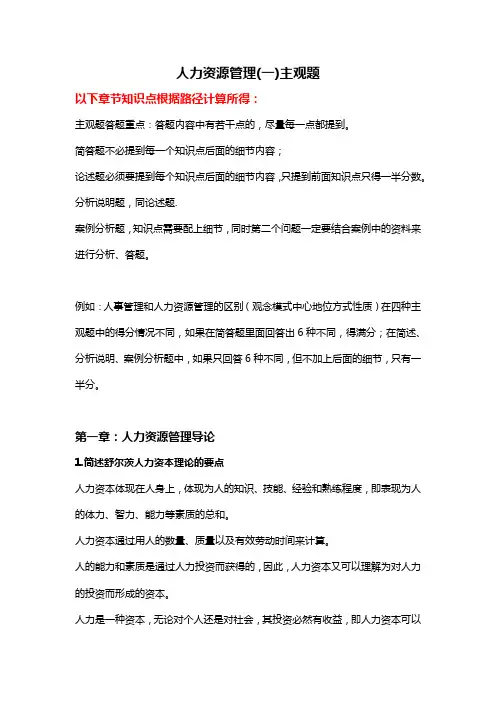
人力资源管理(一)主观题以下章节知识点根据路径计算所得:主观题答题重点:答题内容中有若干点的,尽量每一点都提到。
简答题不必提到每一个知识点后面的细节内容;论述题必须要提到每个知识点后面的细节内容,只提到前面知识点只得一半分数。
分析说明题,同论述题.案例分析题,知识点需要配上细节,同时第二个问题一定要结合案例中的资料来进行分析、答题。
例如:人事管理和人力资源管理的区别(观念模式中心地位方式性质)在四种主观题中的得分情况不同,如果在简答题里面回答出6种不同,得满分;在简述、分析说明、案例分析题中,如果只回答6种不同,但不加上后面的细节,只有一半分。
第一章:人力资源管理导论1.简述舒尔茨人力资本理论的要点人力资本体现在人身上,体现为人的知识、技能、经验和熟练程度,即表现为人的体力、智力、能力等素质的总和。
人力资本通过用人的数量、质量以及有效劳动时间来计算。
人的能力和素质是通过人力投资而获得的,因此,人力资本又可以理解为对人力的投资而形成的资本。
人力是一种资本,无论对个人还是对社会,其投资必然有收益,即人力资本可以带来利润。
2.简述人力资源管理的主要活动。
工作分析、人力资源规划、招聘管理、人员素质测评、员工培训、绩效管理、薪酬管理、职业生涯规划。
3.简述人力资源管理的作用。
协助组织完成目标获取和整合符合标准的人力资源使组织中员工的技能和能力得到充分发挥使员工的工作满意度和自我实现得到最大程度的提升与员工沟通人力资源管理政策和制度。
4.“社会人”假说的管理措施:(1)理人员在注重完成任务的同时,也要关注人,重视满足人的社会需要,培养员工的归属感;(2)在实行奖励时,提倡集体奖励制度;(3)重视非正式组织的作用。
5.试述人力资源管理的发展趋势。
人本管理成为人力资源管理的中心思想;人力资源管理全面参与组织战略管理过程;人力资源管理全球化:培养全球化概念、培养写作与团队精神、培养全球范围内的有效沟通。
人力资源管理的重心为知识型员工的管理。
Content1. Definition of Human Resource Management (2)2. Differences between HRM and PM (2)3. Four stages of HRM development (5)4.Key functions of HRM (5)5. Reference (5)Definition of Human Resource ManagementHuman resource management (HRM, HM) is the function within an organization that focuses on recruitment of, management of, and providing direction for the people who work in the organization. HRM can also be performed by line managers.[1]HRM is an organizational function that deals with issues related to people such as compensation, hiring, performance management, organization development, safety, wellness, benefits, employee motivation, communication, administration, and training etc. [2]HRM is also a strategic and comprehensive approach to managing people and the workplace culture and environment. Effective HRM enables employees to contribute effectively and productively to the overall company direction and the accomplishment of the organization's goals and objectives. [3]HRM is moving away from traditional personnel, administration, and transactional roles, which are increasingly outsourced. HRM is now expected to add value to the strategic utilization of employees and that employee programs impact the business in measurable ways. The new role of human resource management involves strategic direction and human resource management metrics and measurements to demonstrate value. [4]Differences between HRM and PMPersonnel management (PM) is basically an administrative record-keeping function, at the operational level. PM attempts to maintain fair terms and conditions of employment, while at the same time, efficiently managing personnel activities for individual departments etc. It is assumed that the outcomes from providing justice and achieving efficiency in the management of personnel activities will result ultimately in achieving organizational success. [5]HRM is concerned with carrying out the same functional activities traditionally performed by the personnel function, such as HR planning, job analysis, recruitment and selection, employee relations, performance management, employee appraisals, compensation management, training and development etc. But, the HRM approach performs these functions in a qualitatively distinct way, when compared with personnel management.The following are several main differences between PM and HRM:1) PM is workforce-centered, directed mainly at the orga nization’s employees; such as finding and training them, arranging for them to be paid, explaining management’s expectations, justifying management’s action s etc. Nevertheless, HRM is resource–centered, directed mainly at management, in terms of devolving theresponsibility of HRM to line management and administrative development etc.2) Although indisputably an administrative function, PM has never totally identified with management interests, as it becomes ineffective when not able to understand and articulate the aspirations and views of the workforce, just as sales representatives have to understand and articulate the aspirations of the customers.3) PM is basically an operational function, concerned primarily with carrying out the day-to-day people management activities. HRM is strategic in nature, which is, being concerned with directly assisting an organization to gain sustained competitive advantages.4) HRM is more proactive than PM. PM is about the maintenance of personnel and administrative systems; HRM is about the forecasting of organizational needs, the continual monitoring and adjustment of personnel systems to meet current and future requirements, and administration changes.Four stages of HRM developmentSocial Justice●The origins of personnel management lie in nineteenth century, deriving from thework of social reformers such as Lord Shaftesbury and Robert Owen.●Their criticism of the free enterprise system and the leadership created by theexploitation of workers by factory owners enabled the first personnel managers to be appointed and provided the first frame of reference in which they worked: to ameliorate the lot of workers●Such concerns are not obsolete. There are still regular reports of employees beingexploited by employers flouting the law, and the problem of organizational distance between decision makers and those putting decisions into practice remains a source of alienation from work.●In the nineteenth and early twentieth centuries some of the larger employers witha paternalist outlook began to appoint welfare officers to manage a series of newinitiatives designed to make less harsh of their employees.●Prominent examples were the progressive schemes of unemployment benefit, sickpay and subsidized housing provided by the Quaker family firms of Cadbury and Rowntree, and Lever Brothers’ soap business.●While the motives were ostensibly charitable, there was and remains a business aswell as an ethical case for paying serious attention to the welfare of employees.●This is based on the contention that it improves commitment on the part of staffand leads potential employees to compare the organization favorably competitors.●The result is higher productivity, a longer-serving workforce and a bigger pool ofapplicants for each job. It has also been argued that a commitment to welfare reduces the scope for the development of adversarial industrial relations.●The more conspicuous welfare initiatives promoted by employers today includeemployee assistance schemes, childcare facilities and health-screening programs.Human Bureaucracy●This phase marked the beginnings of a move away from a sole focus on welfaretowards the meeting of various other organizational objectives. Personnel managers began to gain responsibilities in the areas of staffing, training and organization design.●Influenced by social scientists such as F.W. Taylor and Henri Fayol personnelspecialists started to look at how organizational structures could be designed and labor deployed so as to maximize efficiency.●The human bureaucracy stage in the development of personnel thinking was alsoinfluenced by the Human Relations School, which sough to ameliorate the potential for industrial conflict and dehumanization present in too rigid an application of these scientific management approaches.●Following the ideas of thinkers such as Elton Mayo, the fostering of socialrelationships in the workforce and employee morale thus became equally important objectives for personnel professionals to raise productivity levels. Consent by negotiation●Personnel managers next added expertise in bargaining to their repertoire ofskills.●In the period of full employment following the Second World War labor became ascarce resource. This led to a growth in trade union membership and to what Alian Flanders, the leading industrial relations analyst of the 1960s, called “the challenge from below”.●Personnel specialists managed the new collective institutions such as jointconsultation committees, joint production committees and suggestion schemes set up in order to accommodate the new realities. In the industries that were nationalized in the 1940s, employers were placed under a statutory duty to negotiate with unions representing employees.●To help achieve this, the government encouraged the appointment of personnelofficers and set up the first specialist courses for them in the universities.● A personnel management advisory service was also set up at the Ministry ofLabor, which still survives as the first A in ACAS.Organization and Integration●The late 1960s saw a switch in focus among personnel specialists, away fromdealing principally with the rank-and-file employee on behalf of management, towards dealing with management itself and the integration of managerial activity.●This phase was characterized by the development of career paths and ofopportunities within organizations for personal growth.●This too remains a concern of personal specialists today, with a significantportion of time and resources being devoted to the recruitment, development and retention of an elite core of people with specialist expertise on whom the business depends for its future.●Personnel specialists developed techniques of manpower or workforce planning.This is basically a quantitative activity, boosted by the advent of information technology, which involves forecasting the likely need for employees with different skills in the future.Key functions of HRM1)Human resource planning or employment planning is the process by which anorganization attempts to ensure that it as the right number of qualified people in the right jobs at the right time2)Job analysis defines a job in terms of specific tasks and responsibilities andindentifies the abilities, sills and qualifications needed to perform it successfully.3)Employee recruitment is the process of seeking and attracting a pool ofapplicants from which qualified candidates for job vacancies within an organization can be selected.4)Employee selectio n involves choosing from the available candidates theindividual predicted to be most likely to perform successfully in the job.5)Performance appraisal is concerned with determining how well employees aredoing their jobs, communicating that information to employees and establishing a plan for performance improvement.6)Training and development activities help employees learn how to perform theirjobs, improve their performance and prepare themselves for more senior positions.7)Career planning and development activities benefit both employees and theorganizations.8)Employee motivation is vital to the success of any organization. Highlymotivated employees tend to be more productive and have rates of absenteeism and turnover.Reference1.Armstrong, Michael (2006). A Handbook of Human Resource Management Practice(10th ed.). London: Kogan Page. ISBN 0-7494-4631-5. OCLC 622822482. Towers, David. "Human Resource Management essays".http://www.towers.fr/essays/hrm.html. Retrieved 2007-10-17.3. By Susan M. Heathfield, Guide/od/glossaryh/f/hr_management.htm4. Pfeffer, J. (1994) Competitive advantage through people, Harvard Business School 4 /od/glossaryh/f/hr_management.htm5.‘Personnel management’. The Columbia Encyclopedia (Sixth ed.). Columbia University Press. 2005. /65/x-/X-personne.html. Retrieved 2007-10-17. "Personnel management - see industrial management".。
高级经济师人力资源管理教材引言人力资源管理是现代组织管理中不可或缺的重要环节,而高级经济师是在这一领域中具备高级管理能力和经济学知识的专业人士。
本教材旨在为高级经济师提供一套全面且深入的人力资源管理知识体系,帮助他们更好地应对组织内的人力资源挑战,提升组织绩效。
第一章:人力资源管理导论1.1 人力资源管理的定义和作用•人力资源管理的概念和范围•人力资源管理对组织的重要性和影响1.2 人力资源策略与组织战略的关系•人力资源策略的概念和目标•人力资源策略与组织战略的一体化第二章:人力资源规划与招聘2.1 人力资源规划的概念和步骤•人力资源需求预测与分析•人力资源供给与评估•人力资源缺口分析与解决方案2.2 招聘与选拔•招聘渠道与方法•面试与评估•人才选拔与录用第三章:绩效管理与激励3.1 绩效管理的重要性和步骤•目标设定与绩效评估•绩效反馈与奖惩机制•绩效管理与职业发展3.2 激励制度设计与管理•薪酬体系设计与管理•福利和奖励制度•员工参与与满意度调查第四章:员工培训与发展4.1 培训与发展的重要性和方法•培训需求分析•培训计划与内容设计•培训方式与评估4.2 职业发展与继续教育•职业发展规划与路径•继续教育的重要性和方法•职业发展与组织发展的关系第五章:员工关系与离职管理5.1 员工关系管理•员工满意度调查与分析•冲突管理与团队建设•企业文化与员工参与5.2 离职管理与员工流失分析•离职手续与管理流程•员工流失原因分析与改进措施•离职风险管理与员工留存结语本教材涵盖了高级经济师人力资源管理的基本理论和实践方法,对于提升高级经济师在人力资源管理领域的专业水平和能力至关重要。
希望本教材对你的学习和实践有所助益,为你的职业发展和组织带来更大的价值。